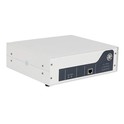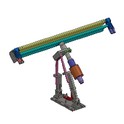Hey there! As a supplier of ResoLab lab grade ultrasonicator, I'm super stoked to share with you how these bad - boys work. These ultrasonicators are top - notch tools used in a whole bunch of scientific and industrial fields. Whether you're in a research lab, a quality control department, or an industrial production line, ResoLab ultrasonicators can be a game - changer.
The Basics of Ultrasonication
First off, let's talk about what ultrasonication is. Ultrasonication is all about using ultrasound waves, which are sound waves with frequencies higher than the upper audible limit of human hearing (usually above 20 kHz). In the case of ResoLab ultrasonicators, they operate at specific frequencies that are optimized for different applications.
The main principle behind ultrasonication is a phenomenon called cavitation. Cavitation occurs when ultrasound waves create alternating high - pressure and low - pressure cycles in a liquid medium. During the low - pressure phase, tiny bubbles or cavities form in the liquid. Then, in the high - pressure phase, these bubbles collapse violently. This collapse releases an enormous amount of energy in a very small area.
How ResoLab Ultrasonicators Generate Ultrasound
ResoLab ultrasonicators are designed with precision to generate these powerful ultrasound waves. They typically consist of a power supply, a transducer, and a probe or horn.


The power supply is like the heart of the ultrasonicator. It converts the standard electrical power from your wall outlet into a high - frequency electrical signal. This signal is then sent to the transducer.
The transducer is a crucial component. It's made up of special materials, usually piezoelectric crystals. When the high - frequency electrical signal hits the piezoelectric crystals, they start to vibrate. These vibrations are what generate the ultrasound waves. The transducer is carefully engineered to ensure that it can efficiently convert electrical energy into mechanical vibrations at the right frequency.
The probe or horn is what transfers the ultrasound waves from the transducer into the sample. It's designed to amplify the vibrations and direct them into the liquid or material you're working with. Different ResoLab models come with different probe sizes and shapes, depending on the specific application. For example, if you're working with a small sample in a test tube, a smaller probe would be more suitable. On the other hand, if you're dealing with a large - scale industrial process, a larger and more powerful probe might be needed.
Applications and How the Ultrasonicator Works in Each
Sample Preparation in Labs
In a laboratory setting, ResoLab ultrasonicators are often used for sample preparation. For instance, when you're trying to extract DNA or proteins from cells. The violent collapse of the cavitation bubbles can break open the cell walls, releasing the desired biomolecules.
Let's say you're using a ResoLab - 500 Lab Grade Ultrasonicator for this purpose. You place your cell sample in a small container filled with a suitable buffer solution. Then you immerse the probe into the solution. As the ultrasonicator starts to generate ultrasound waves, the cavitation bubbles form and collapse around the cells. This mechanical force disrupts the cell structure, making it easier to extract the DNA or proteins.
Homogenization
Homogenization is another common application. It's used to make a mixture uniform. For example, in the food industry, you might want to mix oil and water to create an emulsion. With a ResoLab ultrasonicator, the high - energy cavitation can break down the larger droplets of oil into smaller ones and disperse them evenly throughout the water.
The ResoLab - 1000 Lab Grade Ultrasonicator can be a great choice for this. You pour the two immiscible liquids into a container, insert the probe, and turn on the ultrasonicator. The ultrasound waves cause the cavitation bubbles to form and collapse, creating a shearing force that breaks up the droplets and promotes mixing.
Sonochemistry
Sonochemistry is an area where chemical reactions are accelerated by ultrasonication. The high - energy environment created by cavitation can break chemical bonds and initiate reactions that might not occur under normal conditions.
If you're working on sonochemical reactions, the ResoLab - 2000 Lab Grade Ultrasonicator can provide the high - intensity ultrasound needed. When you place your reactants in a reaction vessel and use the ultrasonicator, the cavitation events can generate local hot spots with extremely high temperatures and pressures. These conditions can speed up the reaction rate and sometimes even lead to the formation of new products.
Controlling the Ultrasonication Process
ResoLab ultrasonicators come with user - friendly controls that allow you to precisely control the ultrasonication process. You can adjust parameters such as the amplitude of the ultrasound waves, the duration of the ultrasonication, and the pulse mode.
The amplitude control is important because it determines the intensity of the cavitation. A higher amplitude means more energy is being delivered to the sample, which can lead to more intense cavitation. However, you need to be careful not to set the amplitude too high, as it could damage your sample or the probe.
The duration control lets you decide how long the ultrasonication should last. This is crucial because different applications require different exposure times. For example, in some delicate biological samples, a short ultrasonication time might be sufficient to achieve the desired result without causing too much damage.
The pulse mode is also a handy feature. Instead of running the ultrasonicator continuously, you can set it to pulse on and off. This can be useful in applications where you want to give the sample a break between high - energy ultrasonication periods, reducing the risk of overheating.
Safety Considerations
When using ResoLab ultrasonicators, safety is a top priority. The high - energy ultrasound waves can be dangerous if not handled properly. You should always wear appropriate personal protective equipment, such as safety goggles and gloves.
Also, make sure the ultrasonicator is placed on a stable surface and that the probe is properly inserted into the sample. Avoid touching the probe while the ultrasonicator is running, as it can get very hot due to the mechanical vibrations.
Why Choose ResoLab Ultrasonicators
ResoLab ultrasonicators stand out for several reasons. They are built with high - quality materials, which ensures their durability and reliability. The precision engineering of the transducers and probes guarantees efficient and consistent ultrasonication performance.
Moreover, ResoLab offers a range of models to suit different needs and budgets. Whether you're a small research lab or a large industrial facility, there's a ResoLab ultrasonicator that's right for you.
If you're interested in learning more about our ResoLab lab grade ultrasonicators or are looking to make a purchase, don't hesitate to reach out. We're here to assist you with any questions you might have and to help you find the perfect ultrasonicator for your specific application.
References
- Mason, T. J. (1990). Sonochemistry: the uses of ultrasound in chemistry. Elsevier.
- Suslick, K. S. (1988). Sonochemistry. Science, 247(4941), 1439 - 1445.




